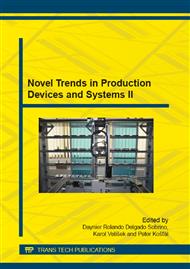p.3
p.9
p.16
p.22
p.30
p.38
p.44
p.50
Layout Redesign and Material Flow Analysis at a Flexible Assembly Cell Supported by the Use of Simulation
Abstract:
This paper essentially emerges from scientific and teaching needs of a university institute while trying deepen into a more formal analysis and/or design process of the material flow and associated manufacturing decisions, e.g.: the layout. Fulfilling such needs, the paper makes allusion to key manufacturing decisions associated to the material flow, while stressing the fact of their mandatory consideration when integrally addressing the primary problem. A partial application of the ideas takes place at a flexible assembly cell of the institute; some of the main results of it are: (1) a more formal description of the whole cell including alternative material flow scenarios, (2) the proposal of a new scenario implying the redesign of the cell conception, i.e.: the layout and thus material flow itself, (3) the simulation and comparison of material flow scenarios selecting the best one in terms of both the MF and layout, among others. At the end, the integration of all these previous elements clearly contributed to the solution of the research’ problem and objectives traced within the frame of the research.
Info:
Periodical:
Pages:
22-29
Citation:
Online since:
December 2014
Price:
Сopyright:
© 2014 Trans Tech Publications Ltd. All Rights Reserved
Share:
Citation:


